stop start Lexus ES350 2008 Workshop Manual
[x] Cancel search | Manufacturer: LEXUS, Model Year: 2008, Model line: ES350, Model: Lexus ES350 2008Pages: 459, PDF Size: 5.93 MB
Page 308 of 459
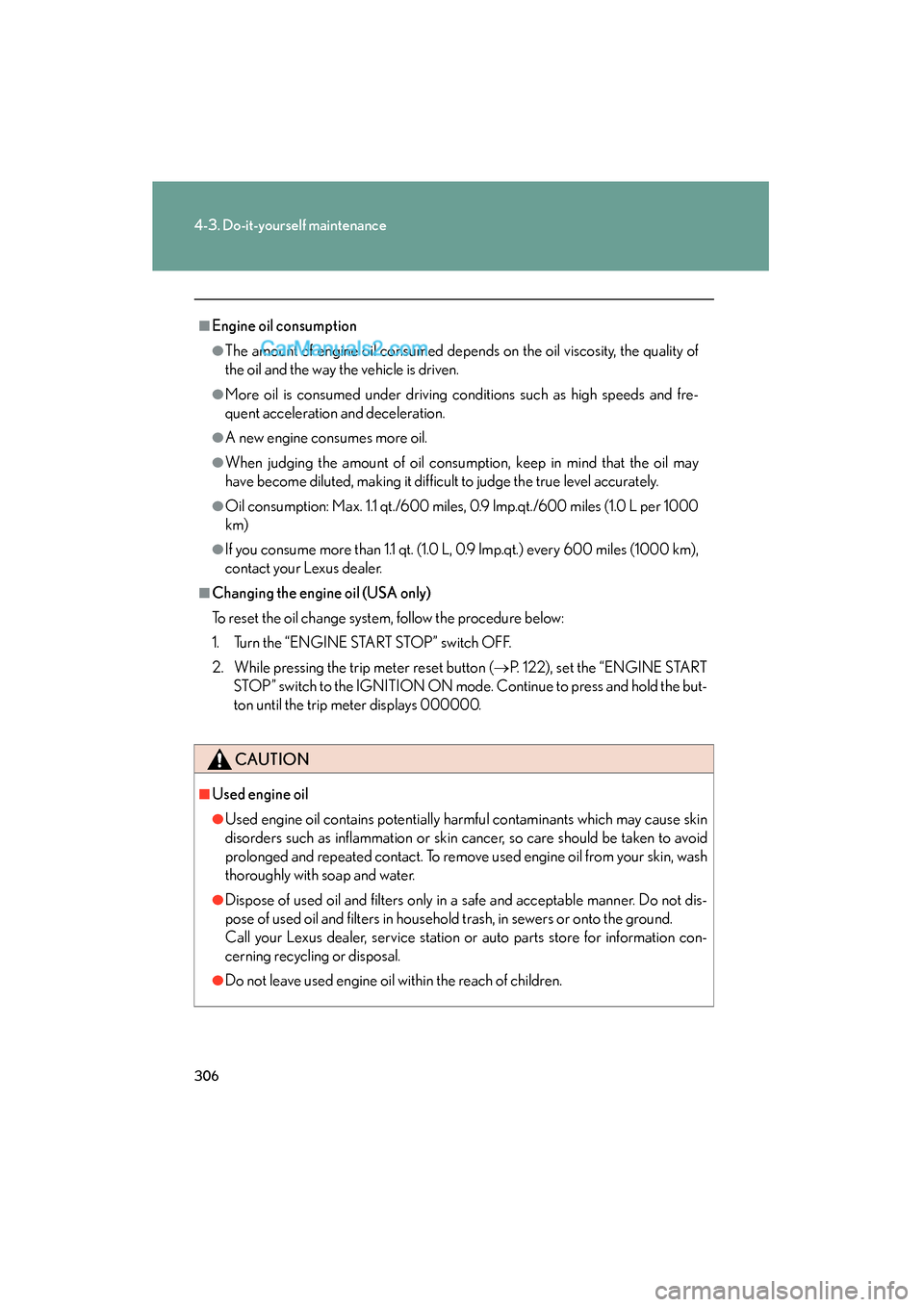
306
4-3. Do-it-yourself maintenance
ES350_U_(L/O_0708)
■Engine oil consumption
●The amount of engine oil consumed depends on the oil viscosity, the quality of
the oil and the way the vehicle is driven.
●More oil is consumed under driving conditions such as high speeds and fre-
quent acceleration and deceleration.
●A new engine consumes more oil.
●When judging the amount of oil consumption, keep in mind that the oil may
have become diluted, making it difficult to judge the true level accurately.
●Oil consumption: Max. 1.1 qt./600 miles, 0.9 lmp.qt./600 miles (1.0 L per 1000
km)
●If you consume more than 1.1 qt. (1.0 L, 0.9 lmp.qt.) every 600 miles (1000 km),
contact your Lexus dealer.
■Changing the engine oil (USA only)
To reset the oil change system, follow the procedure below:
1. Turn the “ENGINE START STOP” switch OFF.
2. While pressing the trip meter reset button (→P. 122), set the “ENGINE START
STOP” switch to the IGNITION ON mode. Continue to press and hold the but-
ton until the trip meter displays 000000.
CAUTION
■Used engine oil
●Used engine oil contains potentially harmful contaminants which may cause skin
disorders such as inflammation or skin cancer, so care should be taken to avoid
prolonged and repeated contact. To remove used engine oil from your skin, wash
thoroughly with soap and water.
●Dispose of used oil and filters only in a safe and acceptable manner. Do not dis-
pose of used oil and filters in household trash, in sewers or onto the ground.
Call your Lexus dealer, service station or auto parts store for information con-
cerning recycling or disposal.
●Do not leave used engine oil within the reach of children.
Page 320 of 459

318
4-3. Do-it-yourself maintenance
ES350_U_(L/O_0708)
Initializing the tire pressure warning system■ The tire pressure warn ing system must be initialized when the tire
inflation pressure is changed (s uch as when changing traveling
speed or load weight.)
When the tire pressure warning system is initialized, the current tire
inflation pressure is set as the pressure benchmark.
■ How to initialize the tire pressure warning system
Park the vehicle in safe place and turn the “ENGINE START
STOP” switch to OFF mode.
While the vehicle is moving, initialization is not performed.
Adjust the tire inflation pressure to the specified cold tire inflation
pressure level. ( →P. 4 1 5 )
Make sure to adjust the tire pressure to the specified cold tire inflation
pressure level. The tire pressure warning system will operate based on
this pressure level.
Turn the “ENGINE START STOP” switch to IGNITION ON
mode.
Push and hold the tire pressure
warning reset switch until the tire
pressure warning light blinks
slowly three times.
Wait for a few minutes with the IGNITION ON mode, and then
turn the “ENGINE START STOP” switch to OFF mode.
STEP1
STEP2
STEP3
STEP4
STEP5
Page 332 of 459
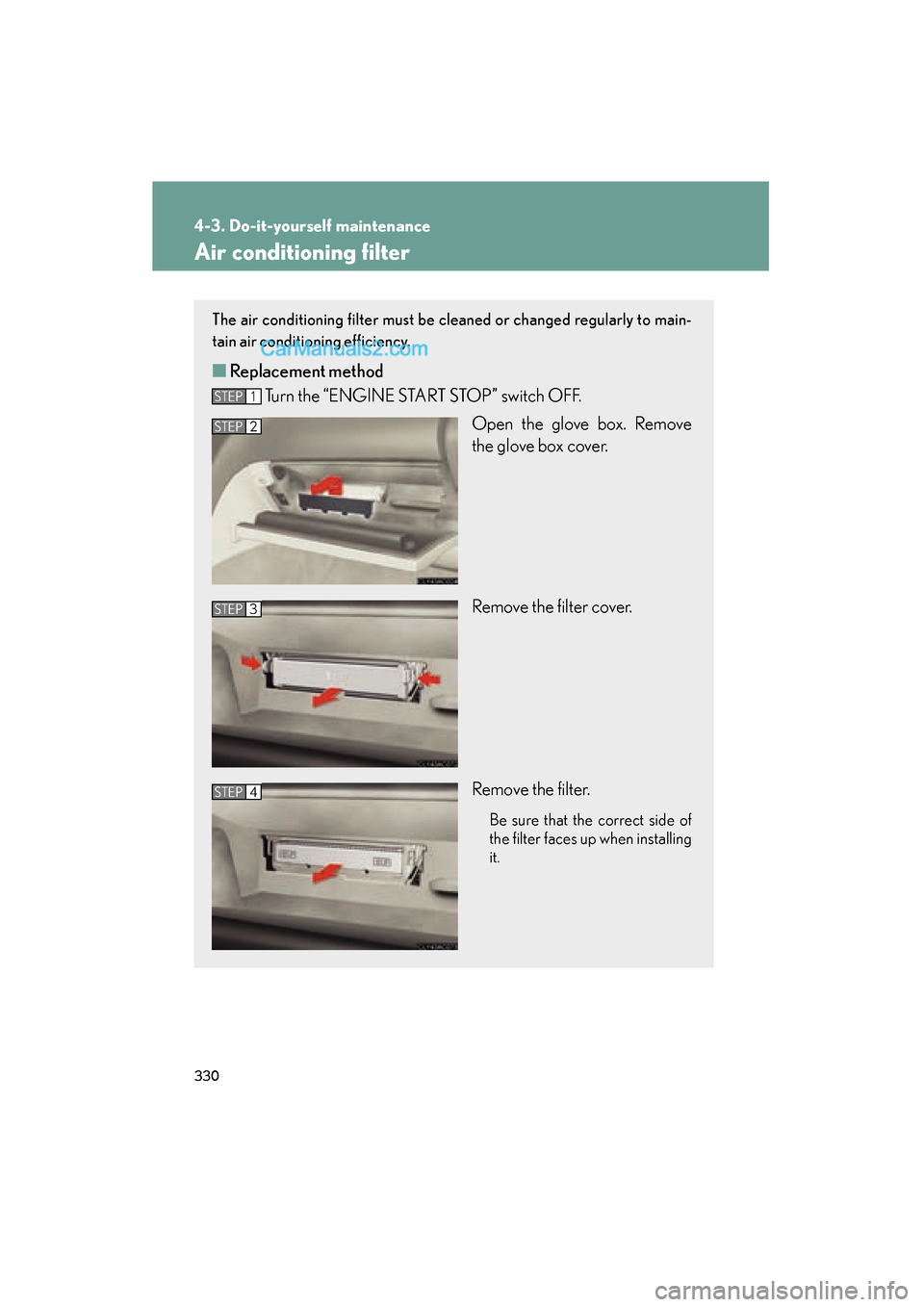
330
4-3. Do-it-yourself maintenance
ES350_U_(L/O_0708)
Air conditioning filter
The air conditioning filter must be cleaned or changed regularly to main-
tain air conditioning efficiency.
■Replacement method
Turn the “ENGINE START STOP” switch OFF.
Open the glove box. Remove
the glove box cover.
Remove the filter cover.
Remove the filter.
Be sure that the correct side of
the filter faces up when installing
it.
STEP1
STEP2
STEP3
STEP4
Page 336 of 459

334
4-3. Do-it-yourself maintenance
ES350_U_(L/O_0708)
Checking and replacing fuses
If any of the electrical components do not operate, a fuse may have blown.
If this happens, check and replace the fuses as necessary.
Turn the “ENGINE START STOP” switch OFF.
Remove the engine compartment cover.
→P. 302
Open the fuse box cover.
Engine compartment
Push the tabs in and lift the lid
off.
Driver's side instrument
panel
Remove the lid.
After a system failure, see “Fuse layout and amperage ratings”
(→ P. 336) for details about which fuse to check.
Remove the fuse with the pull-
out tool.STEP1
STEP2
STEP3
STEP4
STEP5
Page 339 of 459

337
4-3. Do-it-yourself maintenance
4
Maintenance and care
ES350_U_(L/O_0708)
12A LT140 A
PSB, H-LP CLN, P-P/SEAT, RR DEF,
ABS NO.2, FAN MAIN, ABS NO.1,
HTR, RR FOG, RR DOOR RH, RR
DOOR LH, FUEL OPN, FR FOG,
OBD, STOP, TI & TE, A/C, PWR,
DOOR NO.2, S/ROOF, GAUGE
NO.2, POWER, P/SEAT
13STR LOCK20 ASteering lock system
14IG220 A
GAUGE NO.2, IGN, multiport fuel
injection system/sequential multiport
fuel injection system
15HAZ15 ATurn signal lights
16ETCS10 AElectronic throttle control system
17E-ACM10 AElectric active control mount
18A/C CTRL PNL15 AAir conditioning system
19A LT- S7. 5 ACharging system
20AM27. 5 AStarting system
21EFI MAIN30 AEFI NO.2, EFI NO.3, fuel system, ECT
system
22AMP30 AAudio system
23AMP230 AAudio system
24DOOR NO.125 APower door lock system
25R A D I O N O.115 AAudio system
26ECU-B NO.110 AECU powers
27DOME10 AInterior lights, meters, vanity lights
28H-LP (LH)15 ALeft-hand headlight (high beam)
29H-LP (RH)15 ARight-hand headlight (high beam)
FuseAmpereCircuit
Page 355 of 459
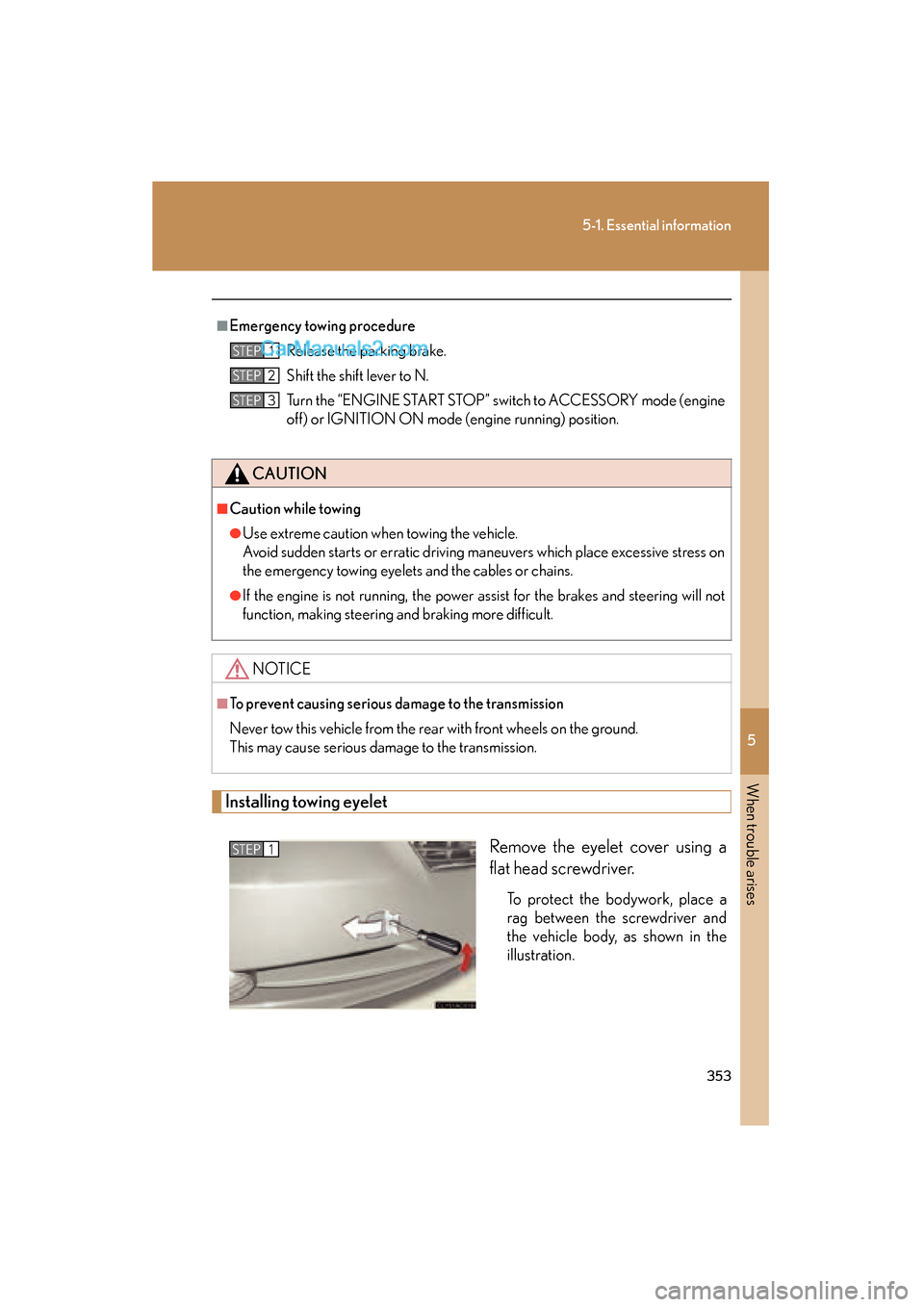
5
When trouble arises
353
5-1. Essential information
ES350_U_(L/O_0708)
Installing towing eyeletRemove the eyelet cover using a
flat head screwdriver.
To protect the bodywork, place a
rag between the screwdriver and
the vehicle body, as shown in the
illustration.
■Emergency towing procedureRelease the parking brake.
Shift the shift lever to N.
Turn the “ENGINE START STOP” switch to ACCESSORY mode (engine
off) or IGNITION ON mode (engine running) position.
CAUTION
■Caution while towing
●Use extreme caution when towing the vehicle.
Avoid sudden starts or erratic driving maneuvers which place excessive stress on
the emergency towing eyelets and the cables or chains.
●If the engine is not running, the power assist for the brakes and steering will not
function, making steering and braking more difficult.
NOTICE
■To prevent causing serious damage to the transmission
Never tow this vehicle from the rear with front wheels on the ground.
This may cause serious damage to the transmission.
STEP1
STEP2
STEP3
STEP1
Page 361 of 459
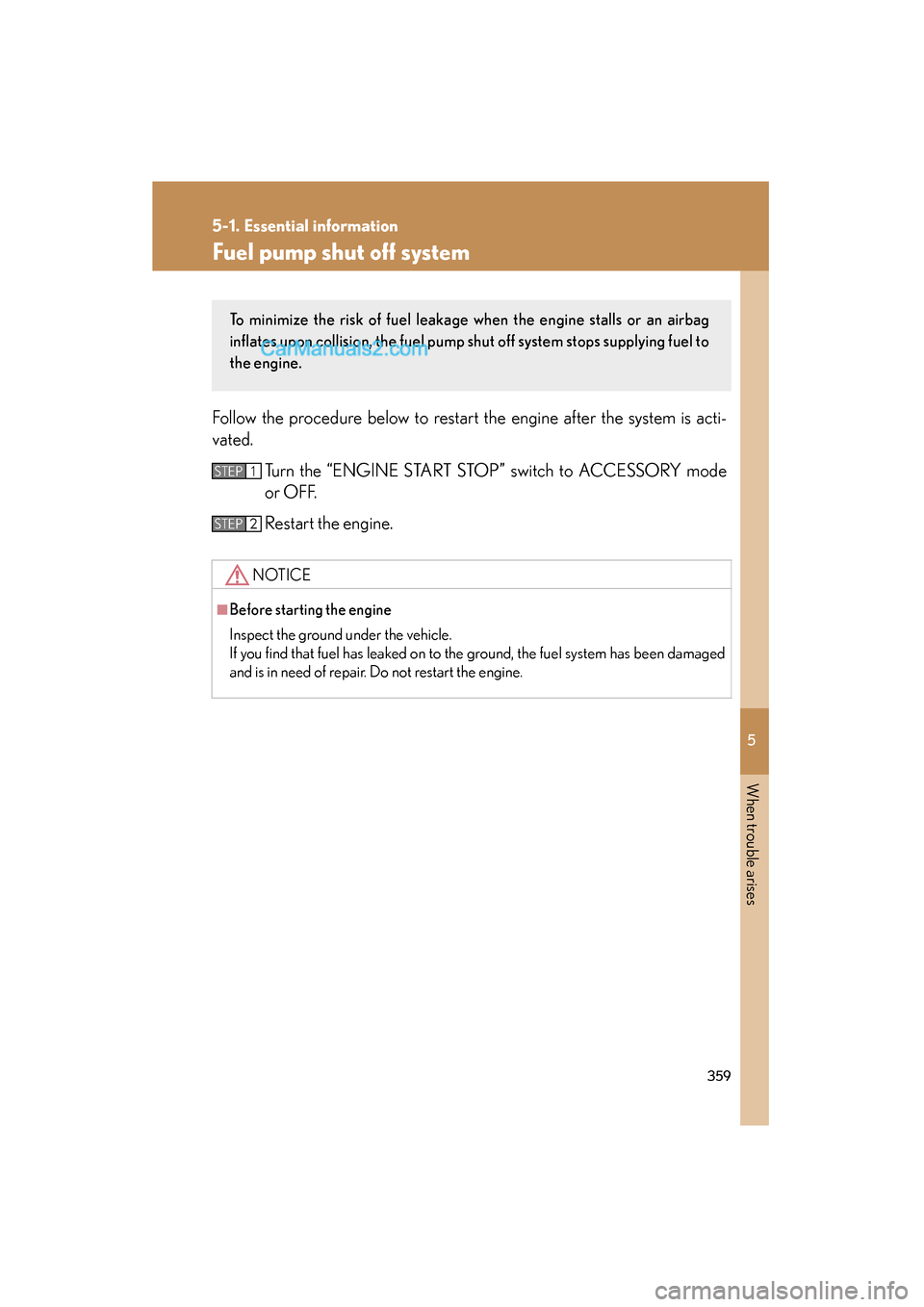
5
When trouble arises
359
5-1. Essential information
ES350_U_(L/O_0708)
Fuel pump shut off system
Follow the procedure below to restart the engine after the system is acti-
vated.Turn the “ENGINE START STOP” switch to ACCESSORY mode
or OFF.
Restart the engine.
NOTICE
■Before starting the engine
Inspect the ground under the vehicle.
If you find that fuel has leaked on to the ground, the fuel system has been damaged
and is in need of repair. Do not restart the engine.
To minimize the risk of fuel leakage when the engine stalls or an airbag
inflates upon collision, the fuel pump shut off system stops supplying fuel to
the engine.
STEP1
STEP2
Page 372 of 459

370
5-2. Steps to take in an emergency
ES350_U_(L/O_0708)
■If the tire pressure warning light comes on after blinking for 1 minute frequently
If the tire pressure warning light comes on after blinking for 1 minute frequently
when the “ENGINE START STOP” switch is turned to IGNITION ON mode, have
it checked by your Lexus dealer.
■Customization that can be configured at Lexus dealer
The vehicle speed linked seat belt reminder buzzer can be disabled. (Customizable
features →P. 433)
CAUTION
■If the tire pressure warning light comes on
Be sure to observe the following precautions. Failure to do so could cause loss of
vehicle control and result in death or serious injury.
●Stop your vehicle in a safe place as soon as possible. Adjust the tire inflation pres-
sure immediately.
●If the tire pressure warning light comes on even after tire inflation pressure adjust-
ment, it is probable that you have a flat tire. Check the tires. If the tire is flat,
change to the spare tire and have the flat tire repaired by the nearest Lexus
dealer.
●Avoid abrupt maneuvering and braking. If the vehicle tires deteriorate, you could
lose control of the steering wheel or the brakes.
■If a blowout or sudden air leakage should occur
The tire pressure warning system may not activate immediately.
Page 373 of 459
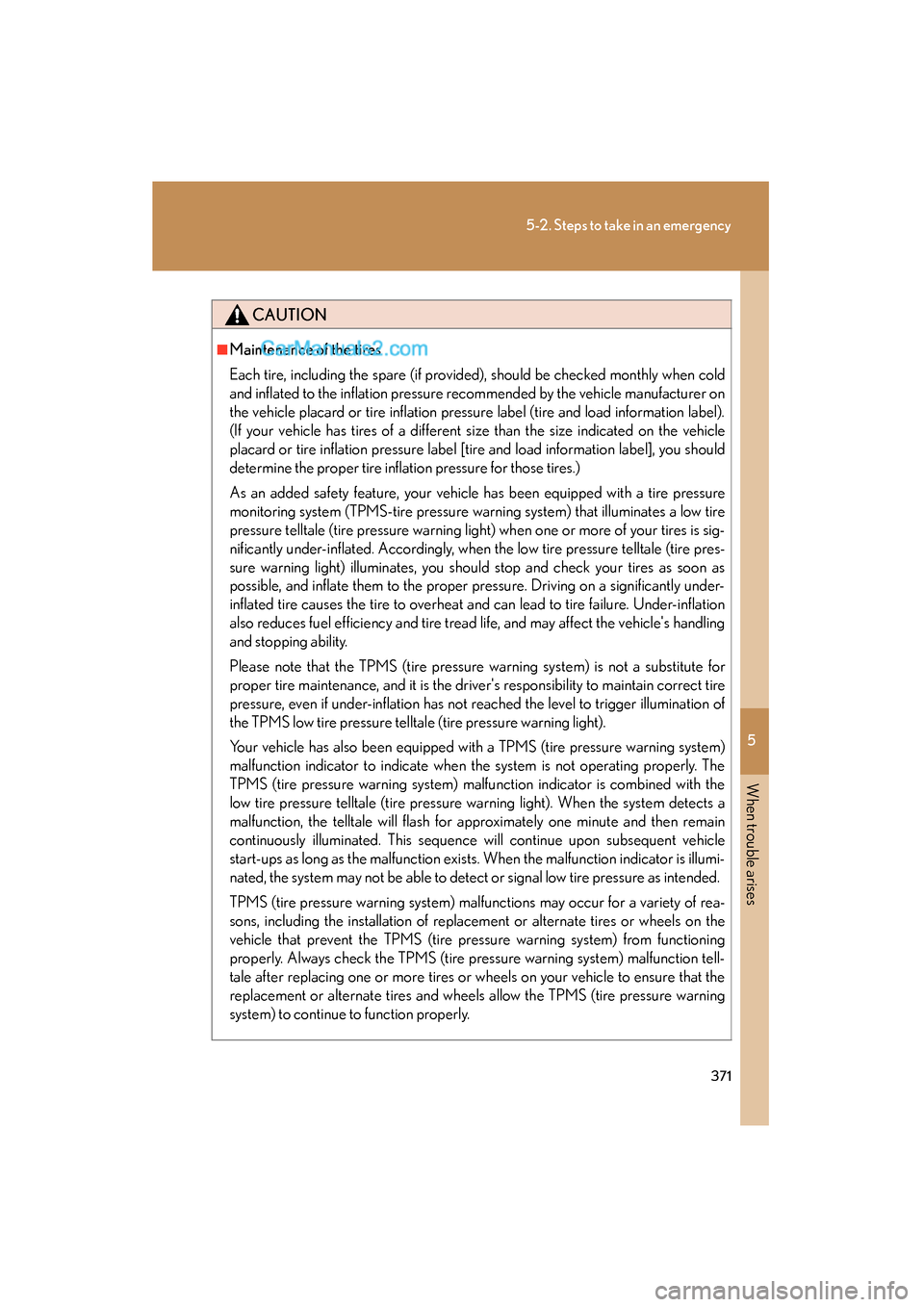
5
When trouble arises
371
5-2. Steps to take in an emergency
ES350_U_(L/O_0708)
CAUTION
■Maintenance of the tires
Each tire, including the spare (if provided), should be checked monthly when cold
and inflated to the inflation pressure recommended by the vehicle manufacturer on
the vehicle placard or tire inflation pressure label (tire and load information label).
(If your vehicle has tires of a different size than the size indicated on the vehicle
placard or tire inflation pressure label [tire and load information label], you should
determine the proper tire inflation pressure for those tires.)
As an added safety feature, your vehicle has been equipped with a tire pressure
monitoring system (TPMS-tire pressure warning system) that illuminates a low tire
pressure telltale (tire pressure warning light) when one or more of your tires is sig-
nificantly under-inflated. Accordingly, when the low tire pressure telltale (tire pres-
sure warning light) illuminates, you should stop and check your tires as soon as
possible, and inflate them to the proper pressure. Driving on a significantly under-
inflated tire causes the tire to overheat and can lead to tire failure. Under-inflation
also reduces fuel efficiency and tire tread life, and may affect the vehicle's handling
and stopping ability.
Please note that the TPMS (tire pressure warning system) is not a substitute for
proper tire maintenance, and it is the driver's responsibility to maintain correct tire
pressure, even if under-inflation has not reached the level to trigger illumination of
the TPMS low tire pressure telltale (tire pressure warning light).
Your vehicle has also been equipped with a TPMS (tire pressure warning system)
malfunction indicator to indicate when the system is not operating properly. The
TPMS (tire pressure warning system) malfunction indicator is combined with the
low tire pressure telltale (tire pressure warning light). When the system detects a
malfunction, the telltale will flash for approximately one minute and then remain
continuously illuminated. This sequence will continue upon subsequent vehicle
start-ups as long as the malfunction exists. When the malfunction indicator is illumi-
nated, the system may not be able to detect or signal low tire pressure as intended.
TPMS (tire pressure warning system) malfunctions may occur for a variety of rea-
sons, including the installation of replacement or alternate tires or wheels on the
vehicle that prevent the TPMS (tire pressure warning system) from functioning
properly. Always check the TPMS (tire pressure warning system) malfunction tell-
tale after replacing one or more tires or wheels on your vehicle to ensure that the
replacement or alternate tires and wheels allow the TPMS (tire pressure warning
system) to continue to function properly.
Page 377 of 459
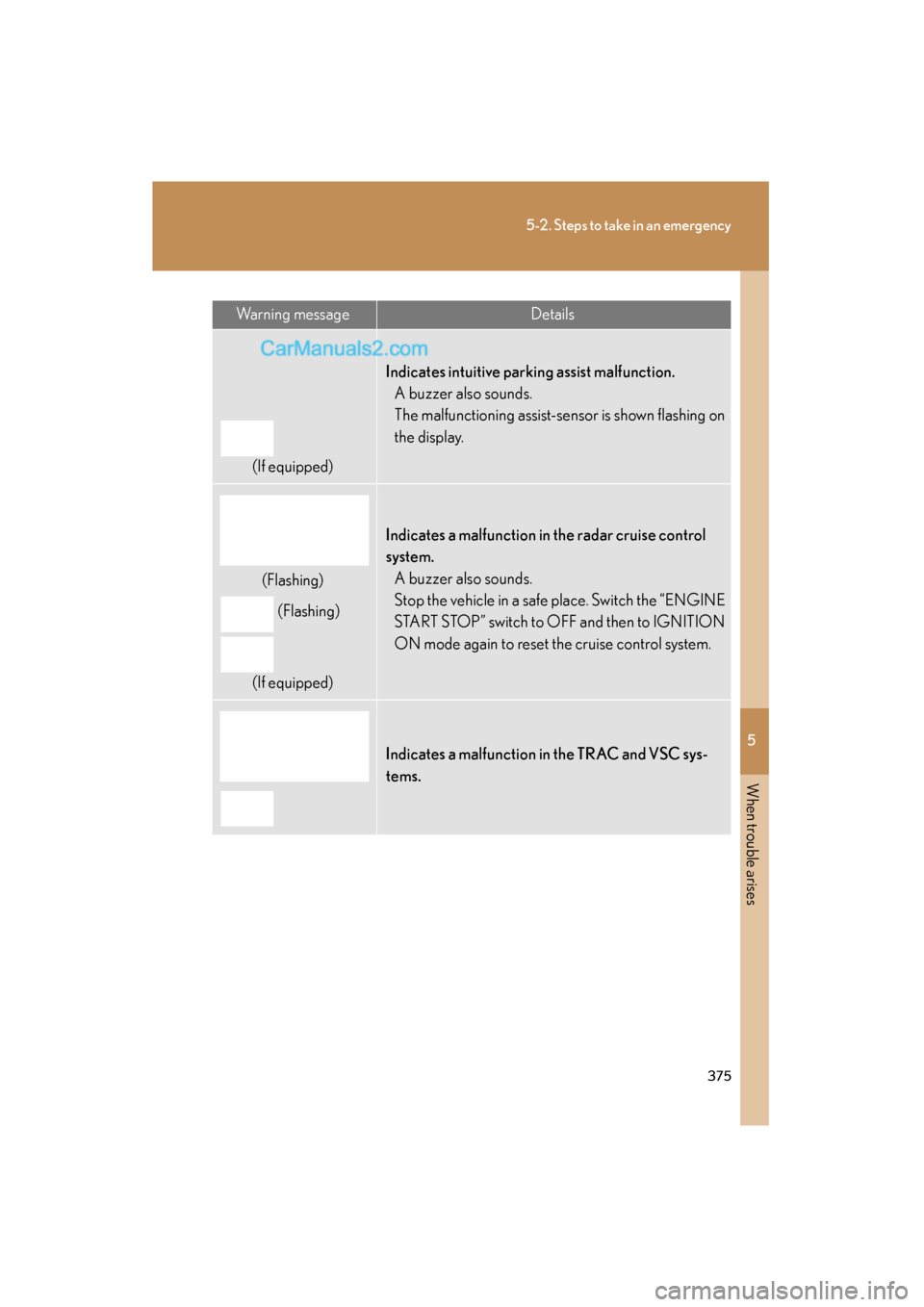
5
When trouble arises
375
5-2. Steps to take in an emergency
ES350_U_(L/O_0708)
Warning messageDetails
(If equipped)
Indicates intuitive parking assist malfunction.A buzzer also sounds.
The malfunctioning assist-sensor is shown flashing on
the display.
(Flashing)
(Flashing)
(If equipped)
Indicates a malfunction in the radar cruise control
system. A buzzer also sounds.
Stop the vehicle in a safe place. Switch the “ENGINE
START STOP” switch to OFF and then to IGNITION
ON mode again to reset the cruise control system.
Indicates a malfunction in the TRAC and VSC sys-
tems.